Share sustainable habits to improve the health of planet Earth. Get started with this list of 12 green living tips for kids and adults!
Here’s a list of green living tips for children and adults. Caring for our environment and planet Earth is a valuable lesson for everyone. As world citizens, it’s our responsibility to help reduce climate change to improve the earth’s future for all. In a world where the urgency of climate change grows more palpable each day, we must help our children (and ourselves) embrace eco-conscious habits by taking tangible steps toward reducing our carbon footprint.
Every choice we make, from the products we consume to the energy we use, can contribute to or help eliminate the environmental challenges we face. Fortunately, simple yet impactful green living tips like those on the list below make it easier to align our daily lives with crucial sustainability principles and pave the way for a healthier planet. Join me on a journey to explore practical strategies for reducing carbon emissions and embracing a more sustainable lifestyle with the green living tips and ideas below. Look at these Earth Day activities and crafts for more green living and eco-friendly activity ideas.
Treat the Earth well. It was not given to you by your parents, it was loaned to you by your children. We do not inherit the Earth from our Ancestors, we borrow it from our Children.
-American Indian Proverb
Eco-Friendly Green Living Tips That Help Reduce Climate Change
Below is a list of twelve easy ways to reduce your carbon footprint and learn to live more sustainably. The eco-friendly green living ideas and positive parenting tips below can help everyone in your family and Mother Earth’s children live in a greener world now and in the future. This post was first published in April 2015 as “Caring for the Earth: 12 Ways to Help Kids Get It” for parents and teachers to help kids learn to be more eco-conscious. However, the green living tips and ideals to strive for are not just for kids. Children and adults of all ages can use each of the concepts below to help create a more sustainable future for generations to come. This list of eco-friendly ideas is regularly updated and republished to improve the content and keep it current. You might also enjoy this list of Earth Day activities and crafts.
12 Eco-Conscious Green Living Tips to Reduce Your Carbon Footprint
Committing to the well-being of our planet and the natural world is an essential value to share with our children and students. These green living tips and ideas can help kids learn to live a low-impact, sustainable life so they can do their part to reduce climate change. Use these Earth Day Printables any day of the year to commit to small changes that make a BIG impact at home with kids (or adults) or in the classroom with students.
First, pick “one small change” from this list of eco-friendly ideas. Next, commit to following through with an Earth Day Pledge (any day of the year) to make the change a habit in your home. Our printable Earth Day Activity Pack and The Dream Life Tool Kit make it easy to commit to small changes that make a big difference over time.
You might also want to grab one of these gorgeous climate change coloring pages from Adventure in a Box for you and your kids (or students). The ideas in this post inspired my friend Liska to create a beautiful coloring page with twelve ideas to help kids reduce climate change. You will notice that her list of conservation tips is slightly different than our list below. However, they align perfectly with the green living ideals in this post. I think she did a fantastic job! Thanks, Liska–you’re amazing! Thank you for joining me in “being the change you wish to see” for our children’s future. Get your climate change coloring poster HERE!
1. Be a Model Citizen:
The most important way to help children care for the Earth is by modeling it yourself. Children do what they see the adults around them doing. They are like little sponges that soak up how we relate to our world and mirror it back to us. Show them a reflection to admire and emulate.
Parents who make eco-conscious choices are more likely to raise eco-conscious children, and vice versa. If you want your children to care about the environment and reduce their impact, they need to see you making changes to help reduce climate change. Children will make more sustainable choices if they see the adults around them making better choices for the future of Planet Earth. Good habits start at home.
Here are a few simple ways to encourage and nurture Kindness to Nature at home or in the classroom. Another fun educational aid is growth mindset books for kids. Children’s books like these can help share eco-conscious concepts and other essential lessons with children of all ages.
2. Tread Lightly; Minimize Your Impact on the Environment:
Tread lightly on the Earth. Reduce your impact on the environment in all possible ways. And please, please, please, do not litter. Let’s each do our part to keep Mother Earth and the natural world beautiful for everyone.
Take only pictures, leave only footprints, kill nothing but time.
Baltimore Grotto
The effect of humanity’s destructive interaction with the Earth is visible at the national, corporate, and individual levels. So if we want to reduce climate change, we must do our part to minimize our impact on the natural world and the environment. This makes any day an excellent day to pledge to the health of our environment–Earth Day or not.
3. Choose (or Make) Eco-Friendly Products:
Everything we do impacts the environment in which we live. Purchasing more sustainable, eco-friendly products (or making DIY eco-friendly products) is a great green living tip because it is essential for the health and well-being of planet Earth and all of Mother Nature’s children.
You can do this by making or choosing natural or eco-friendly gifts, clothes, children’s toys, and everything else you purchase or DIY for your home, garden, business, or place of work. A few suggestions to get you started are listed below:
- Eco-Friendly Baby Toys That Boost Development Naturally
- Eco-Friendly Educational Toys for Toddlers
- Natural Preschool Toys and How They Benefit Development
- Best Open-Ended Toys for Pretend Play
- Gifts for Mom That Will Put You in the Good Book
Another example would be making (or buying) eco-friendly cleaning products. Cleaning products contain harmful chemicals and toxins that are harmful to the environment. And these toxins are even more dangerous for children, especially crawling babies and toddlers, because they touch and taste everything!
Learning how to make cleaning products makes avoiding these harmful toxins in your home easy. And when children grow up making DIY cleaning products, they are likely to continue to do so as adults. So we have several excellent recipes to help you make your own natural cleaning solutions for your home or workplace on the list below. Click the title of each recipe to see the step-by-step instructions for each homemade natural cleaning product.
- How to Make Natural Cleaning Products
- Glass and Window Cleaner
- Wood Cleaner and Polish
- Cleaning Kit for Kids
4. Plant A Garden; Grow and Eat Organic Food:
Gardening is an essential home-life skill to share with children. Learning how to grow food and knowing where it comes from is becoming a lost art. But if it’s impossible to grow a garden where you live, consider container gardening. Another great idea is to rent a plot in a community garden.
Conventionally grown crops deposit many chemicals and toxins into our environment. While produce and other foods traveling from far away harm the health of our planet. And then there’s the packaging that many of these foods come in–think about it.
Growing organic food is an easy way for everyone to help reduce toxins, fossil fuels, and packaging waste in the environment. Planting an organic garden also helps to reduce waste and toxic byproducts in the water table. So we have some gardening tutorials to help you start an organic garden at home on the list below.
- Everything You Need to Know About Composting
- How to Plant Organic Cucumbers
- Start Organic Cumbers and Melons
- How to Plant Organic Tomatoes
- How to Plant a Tree for Arbor or Earth Day
5. Shop Local and Organic:
If you can’t grow your organic food, do your best to buy whole-natural foods and local organic seasonal produce. Farmer’s markets and natural foods stores often carry whole foods and animal products grown or raised near you in most towns and cities. So seek them out to do most of your food shopping whenever possible.
But no matter where you shop, choose whole foods and avoid processed foods as much as possible–organic or not. Processed food is bad for your body, while the packaging and distance it travels to get to you are bad for our environment and the natural world.
So, do your best to shop at thrift stores, garage sales, or Craigslist to purchase gently used items whenever you need something. And, when purchasing new items, shop locally and choose items made by local artisans and companies. In other words, choose to support local mom-and-pop shops over corporations that could care less about your family and town.
When you need to buy something from a company; Vote with your dollars and sense. Purchase from brands doing their best to reduce their impact and make changes that benefit the environment whenever possible. (See below)
Related: How to Make the Best Tasting Green Smoothie EVER!
6. Vote with Your Dollars and Common Sense:
Vote with your dollars and common sense by supporting politicians, shops, companies, organizations, and charities doing their best to do the right thing. I’m a big fan of companies and corporations (from the biggest to the smallest) that do everything in their power, even when it means earning a little less, to reduce climate change and keep this beautiful Earth a green place to live.
So, vote with your dollars by purchasing local items made in your city, state, or country. Do your part to keep your local economy flourishing by spending your money all over town more than online. Or choose to shop directly from brands doing their best to slow climate change in whatever way they can. Discussing these ideas with your children when they are ready to handle such concepts is an eco-conscious parent’s primary duty.
So research brands and companies doing their best to reduce climate change on the World Wide Web or grab the Better World Shopping Guide. It gives you all the necessary details to make a more informed choice. Every dollar makes a difference. I have listed a few of my favorite brands in Gifts for Mom.
7. Get Outside and Connect:
Spending time in nature benefits our mental and physical health and allows children to fall in love with the Earth and all of Mother Nature’s varied creatures. If we want our children to care for the Earth and become the stewards we need to preserve this beautiful and precious planet, children must get outside to experience nature daily. It isn’t easy to care about something you haven’t experienced firsthand.
Sending the kids outside every chance you get is one of the best and easiest ways you can help preserve this planet. Here at Rhythms of Play, we challenge you to Get Outside & Connect daily to help your children become the environmental stewards of tomorrow. The link above shares a quick list of fun outside activities. For a more extensive list of outdoor activity ideas, look at this list of outdoor learning ideas and nature activities for kids.
8. Green Your To-Go:
Committing to making life on the go more sustainable is an excellent way for everyone to help reduce climate change. Look at the list below for fun ways to go green everywhere you travel:
- Green your ride:
- Make your commute, whether to work, school, or the grocery store, “green” by riding your bike, walking, or using public transportation whenever possible. This isn’t always possible depending on your situation, but many people (including most of my family) make this choice daily. Give it a try!
- BYO-Bag:
- “Bring Your Own” reusable bags to all stores, not just the grocery store. My favorite eco-friendly bags originated in my family’s town. I keep several Chico Bags in my car and always carry one in my purse.
- Bring Green To-Go:
- Use reusable to-go products for greening your to-go!
- My favorite portable, reusable water bottles are Klean Kanteens. They have various sizes, lids, colors, and types of food-grade stainless steel to-go bottles, but several others are on the market.
- My favorites are wide-mouth insulated travel mugs and double-walled water bottles that can keep drinks or food hot or cold for hours!
- Minimize single-use plastics (and their environmental impact):
- Below are some of our favorite reusable to-go products that minimize single-use plastics and help reduce climate change:
- Reusable water bottles such as those mentioned above.
- Portable insulated travel mugs.
- Insulated lunch bags and reusable bento box food containers.
- Beeswax food and sandwich wraps, and other eco-friendly to-go containers.
- Portable stainless steel telescopic straws or multi-size and width straw sets for home use. (Everyone in our house has their favorite type of stainless steel straw, which has the benefit of identifying whose drink is left around the house. “That’s not my straw” is my husband’s favorite thing to say to inspire our daughter to put her glass in the dishwasher.)
- Reusable snack bags and stay-fresh silicone food storage bags
- Below are some of our favorite reusable to-go products that minimize single-use plastics and help reduce climate change:
9. Reduce:
Reduce is the first of the three “R‘s” or conservation rules for reducing or eliminating climate change; Reduce, Reuse, Recycle. Use the ideas on the list below to reduce your impact on Earth:
- Power down–turn it off–or unplug it:
- Following these simple directions is one of the easiest ways to reduce energy consumption at home and in the workplace.
- When you leave the house and sleep at night, power down, turn off or unplug electrical appliances in your home.
- For more ideas, see the list below, “How to Reduce Energy Consumption at Home.”
- Reduce waste:
- There are many ways to reduce waste. The best approach is to use as little as possible of everything.
- Reducing waste is another reason to buy local items without packaging.
- Use BYO reusable grocery bags and green to-go items, and pay attention to the waste that most people tend not to notice.
- For example, if you don’t need 30 paper napkins and 20 packets of ketchup, don’t take them. Tell the server, “I don’t need this many, thanks.” Maybe they’ll hand out fewer next time.
- Say No to Single-Use Plastics:
- Plastics are incredibly harmful to the environment. Reduce climate change by saying no to single-use plastics when offered.
- “No, thank you” is one of my favorite phrases. Join me in happily refusing plastic bags, bottles, straws, silverware, and cutlery with a simple “No, thank you” and a smile.
- Purchase or Buy Less:
- Think in terms of priorities using needs and wants:
- Needs always get met, while things we want more than need go through a deliberation process in our home.
- Remind children that not yet doesn’t necessarily mean no.
- When you need something, look for used, local, or handmade options whenever possible.
- Think in terms of priorities using needs and wants:
How to Reduce Energy Consumption At Home:
- Use energy-efficient appliances.
- Turn off lights when you leave rooms.
- Only run a full dishwasher or washing machine.
- Hang clothing to dry whenever possible.
- Turn off the water when washing your hands and dishes, showering, or brushing your teeth.
- Unplug electrical appliances when not in use.
- Turn off the thermostat during the more temperate months of the year. If you keep it on, set it low in the winter and high in the summer to use less energy.
- Start wearing extra clothes in the winter and less clothing in the summer to prevent the need to turn on the heater (or the air conditioner).
10. Reuse:
The second of the three “R‘s” or conservation rules is reuse, and you will notice that the ideas on the list below ride in tandem with reducing (above) and upcycling (below). That’s why they have become the primary rules for reducing climate change and a common household phrase: reduce, reuse, recycle.
- Use green-to-go wear and reusable bottles and coffee cups.
- Shop at garage sales, thrift stores, used clothing stores, and Craigslist.
- Give and accept hand-me-downs.
- Save recyclables and DIY scraps for crafts and projects. (If you don’t do a lot of arts & crafts or DIY projects, this is not the tip for you–it will only produce clutter!)
11. Recycle, Upcycle, and Renew:
The third “R” of conservation is recycling, upcycling, or renewing! Try the ideas below to reduce climate change in your home or workplace:
- Recycle:
- Do your best to recycle everything you can.
- If it’s not already a habit, make it one. Make green living fun, and your children will retain it for life.
- First, invite children to collect, take out, and sort the recyclables in your home to redeem for cash.
- Next, allow them to use the money they earn to buy a special treat or put it towards their college savings.
- Upcycle or Renew:
- Keep an organized “upcycle” bin in your house filled with items that can be made into something else or renewed.
- Transform trash into treasure:
- You can use recyclables and stuff you find at thrift stores to make upcycled or recycled crafts, games, furniture, toys, etc.
- For example, invite kids to make birdhouses out of toilet paper rolls or upcycled Easter Baskets from recycled materials.
12. Plant a Tree:
Help Mother Earth (and all her varied creatures) thrive today and into the future by planting trees. Plant trees or support companies that do (like the Arbor Day Foundation). Planting trees is a simple activity to help reduce climate change. I love hugging and planting trees!
My mom is one of the most amazing gardeners with the greenest thumb. She’s the Johnny Appleseed of my family may she rest in peace. Fortunately, before she departed this beautiful green and blue planet, she helped me prepare a tree-planting tutorial and a few gardening tips to help you get started. Learn how to plant a tree with her fantastic tree tutorial–> HERE.
If you can’t plant a tree, hug a tree! I like to get outside and hug trees daily for my psychological health, happiness, and well-being. But please don’t be THAT person. If it is not for you, please don’t use “tree-hugger” as an insult like my ex-brother-in-law. Or, like him, you may end up the outcast. True story.
Use the Power of Habit To Help Reduce Climate Change One Green Living Tip at a Time
If these eco-friendly green living tips to reduce climate change seem daunting. I suggest trying one of the green living tips from the list of eco-friendly and eco-conscious ideas above one at a time. Build a culture and weekly rhythm in your home, classroom, or workplace that supports everyone in working toward creating positive change in their lives.
Read about the incredible power of habit to make positive lasting change second nature. Your children will learn to follow your example. If you haven’t already, grab a copy of the QuickStart Weekly Planning Guide to help you plan your daily and weekly rhythm.
You might also enjoy these Earth Day Printables (for use any day of the year). Or these gorgeous climate change coloring pages from Adventure in a Box for you and your kids (or students). The ideas in this post inspired my friend Liska to create a beautiful coloring page with twelve ideas to help kids reduce climate change.
As mentioned above, you will notice that her list of ways to reduce climate change for kids slightly differs from ours but aligns perfectly. I think she did a fantastic job, and she gave us a free copy as one of the sources of her inspiration. Thanks, Liska! You’re amazing! Thank you for joining me in “being the change you wish to see” and becoming a #1 Model Citizen for our children’s future. Get your climate change coloring poster HERE!
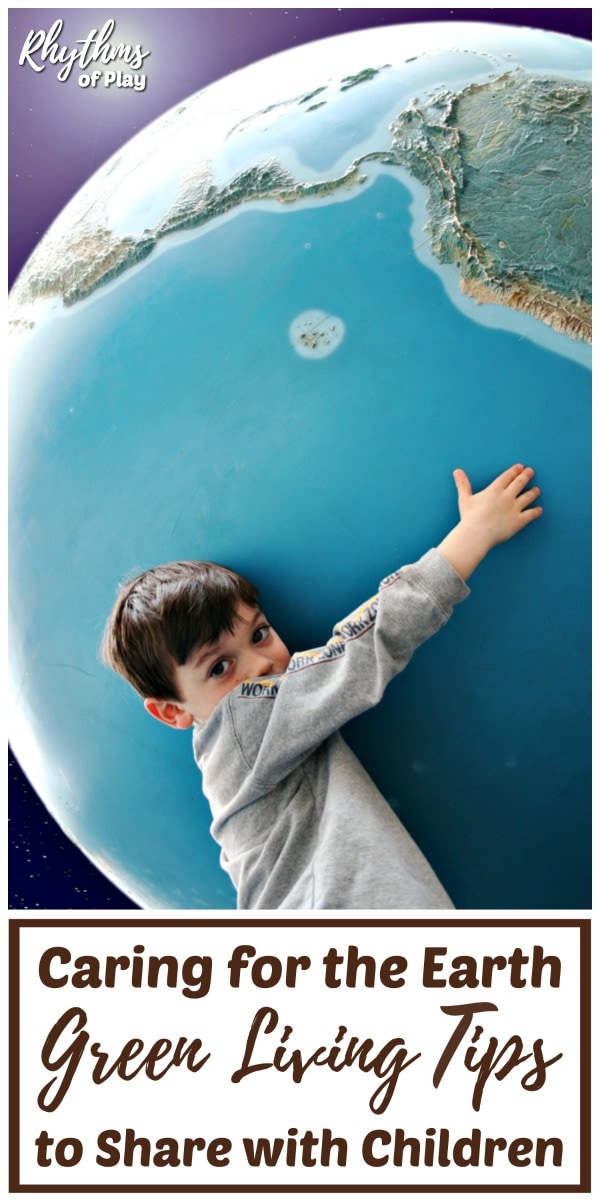
Green Living Ideas: Helping Children Learn to Make Sustainable Choices That REduce Climate Change
Caring for the Earth and making environmentally sustainable choices to reduce climate change are essential skills to share with our children. I hope you’ve enjoyed these Earth Day green living ideas and parenting tips for Kids.
Remind children that the Earth’s future depends on our choices today. Encourage your children or students to commit to “one small change” at a time by turning each one into a pledge to the Earth. Download the Pledge to the Earth Printable or the entire Earth Day Activity Pack to use at home with kids (or adults) or the students in your classroom.
But remember, no one is perfect. We all have not-so-great habits that are challenging to give up. Mistakes are how we learn to do better next time. So, don’t forget to go easy on yourself and your children as we each learn to treat our “Mother” (Earth and nature) a little better every day. Every little bit helps. “A bucket would never be full if not for each drop.” ~NRK
Learn more about Rhythms of Play HERE!

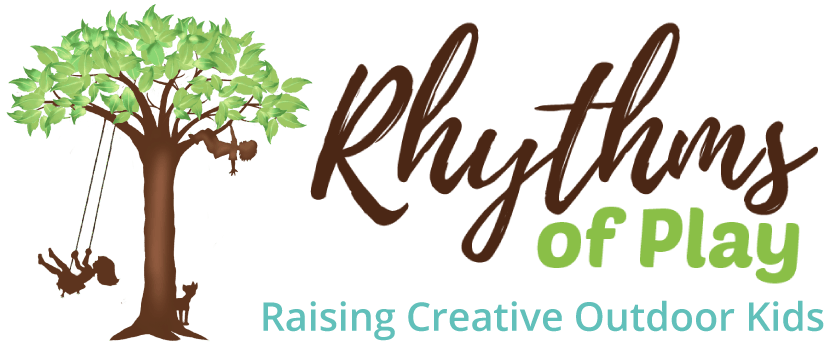
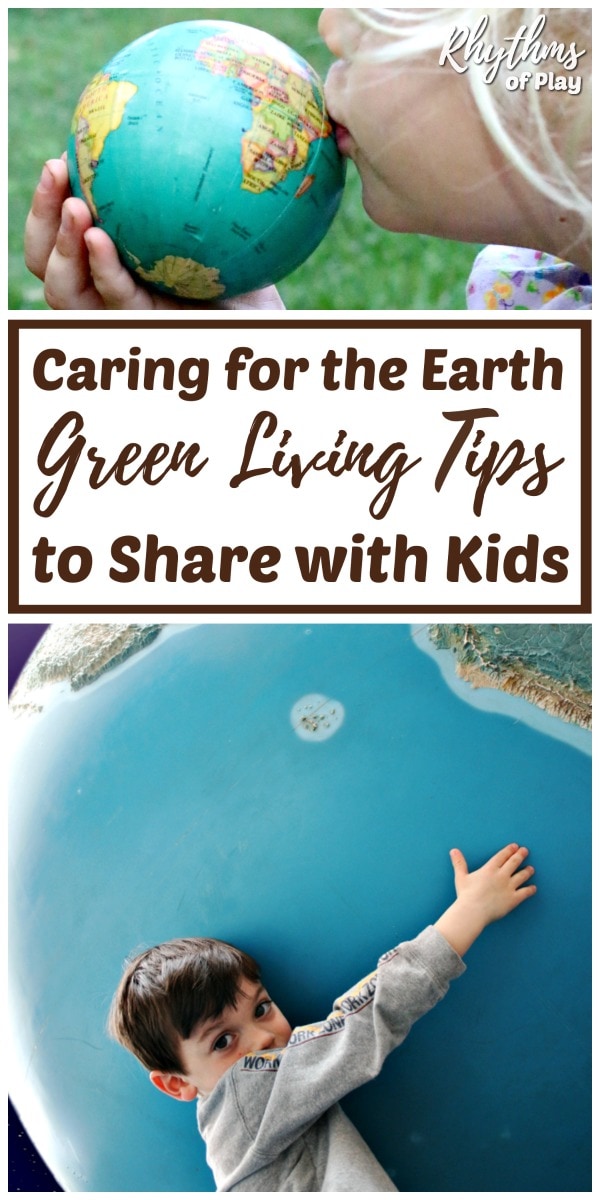
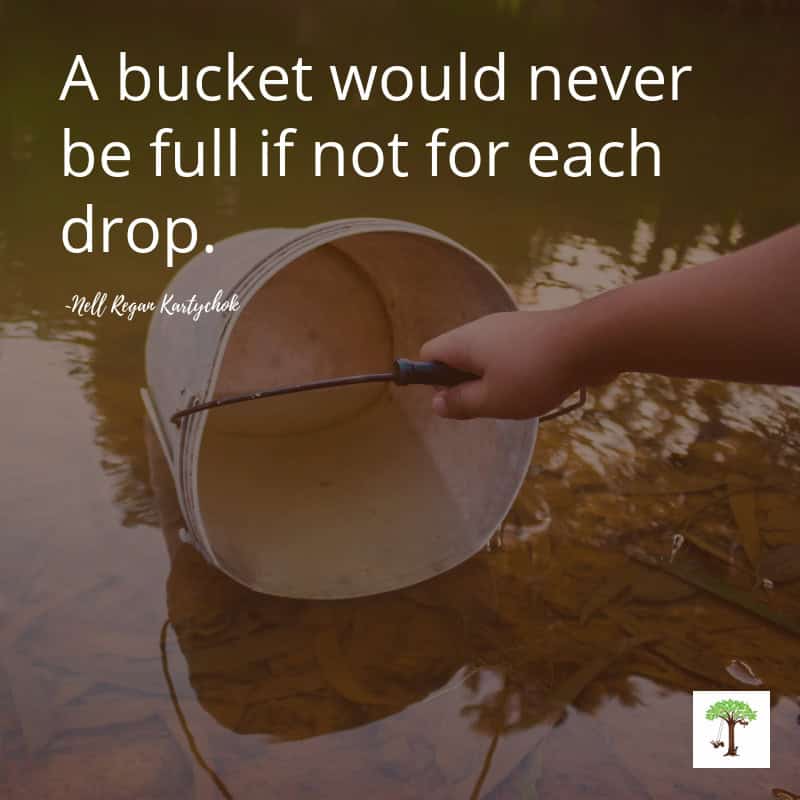
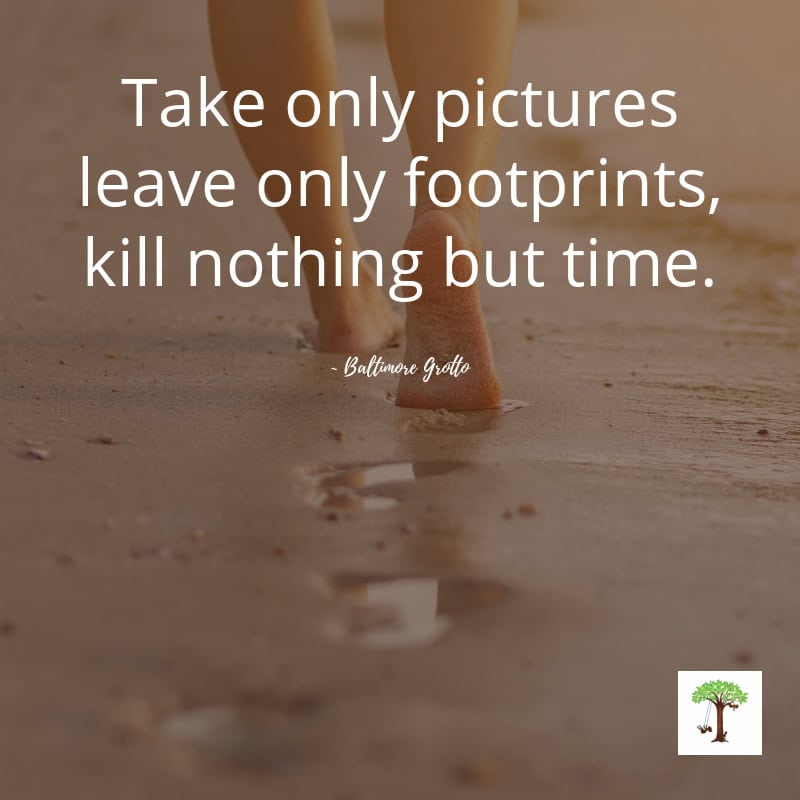
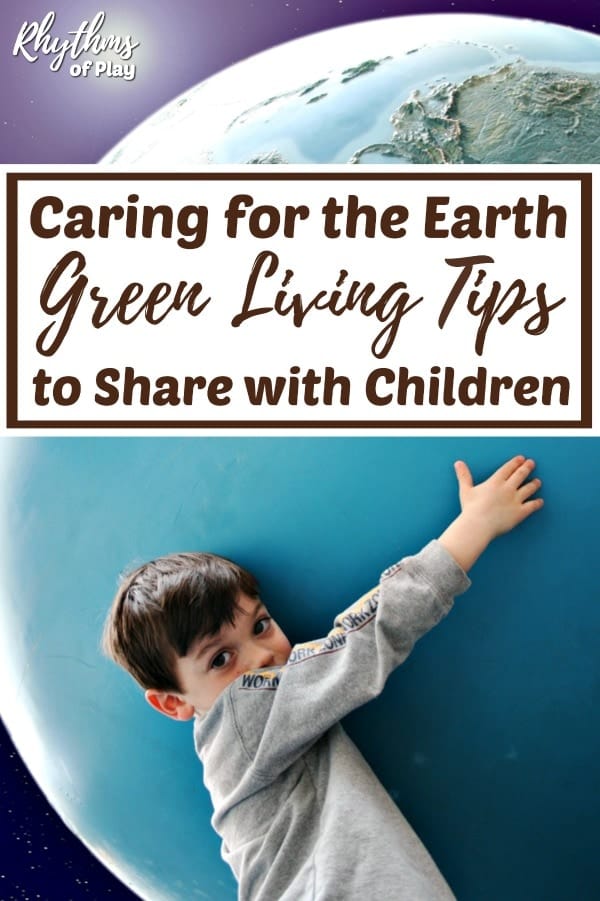
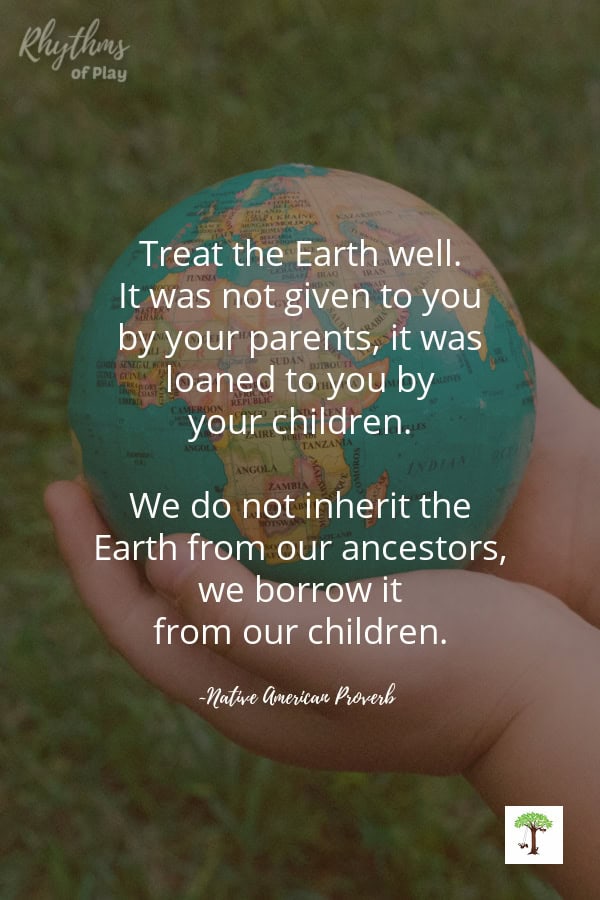
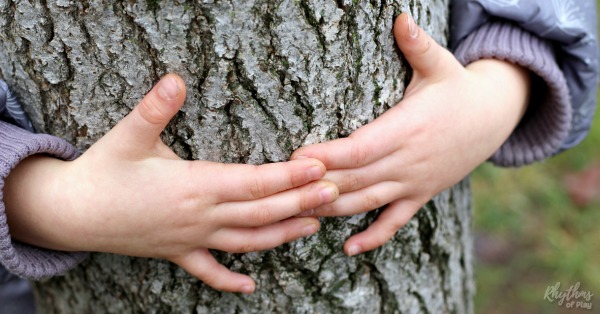

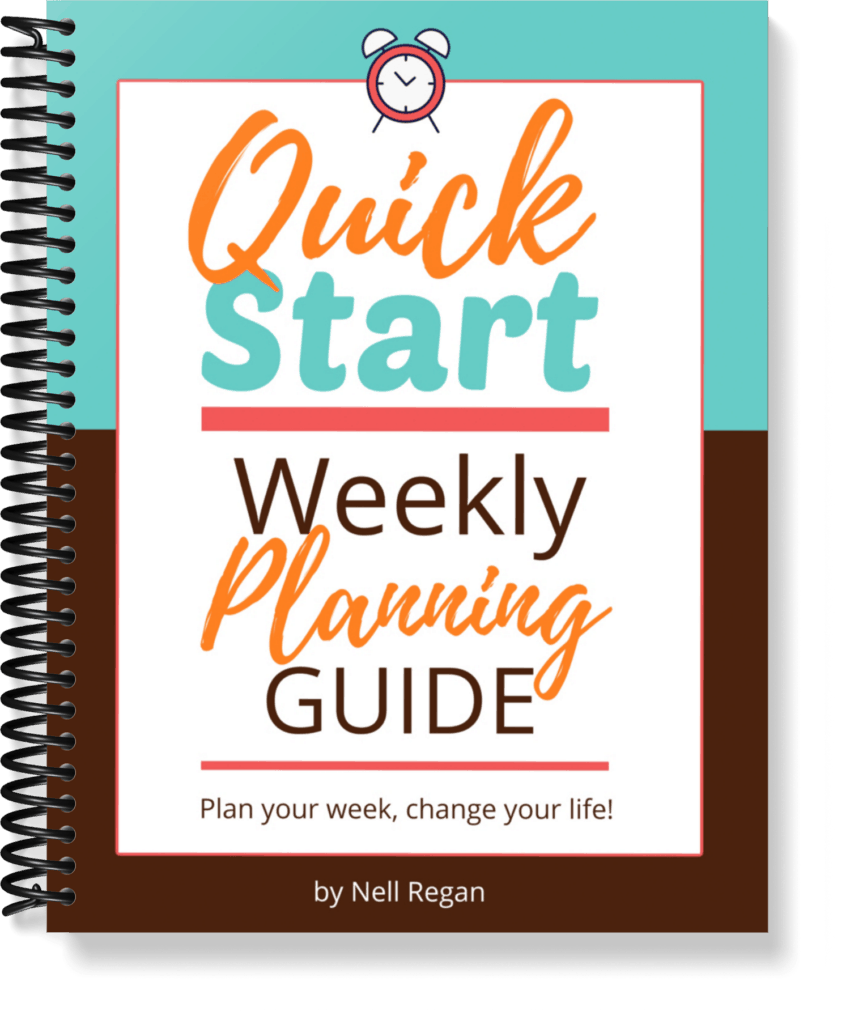
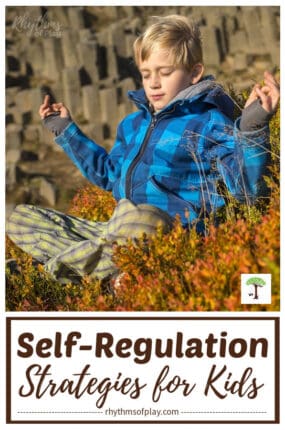

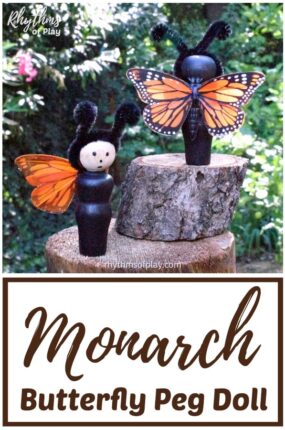

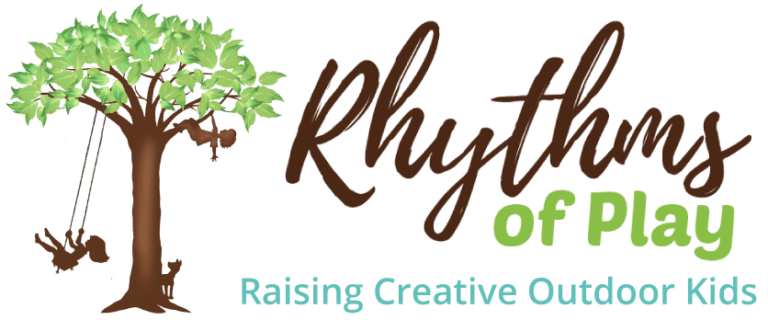
I love your tips — so many that the kids can help with at any age! We try to do many of these but there’s always room for improvement 🙂 This year, we’re working on making our own cleaners.
We are nowhere near perfect when it comes to green living either Jacquie… we do our best with every moment and choice that passes. Some days are good, and some are not so good. All that matters is we are striving to be more green every day. Glad your making your own cleaning products — that has a lasting positive impact 🙂
Becoming a mother has made me very conscious about setting the right example for my kids, especially when it comes to caring for the environment. It’s easy to get lazy, but I try to remind myself that they are soaking up every move I make and will emulate it someday! Great article 🙂
Thanks, Skye 🙂
It’s amazing how much they soak up! I cringe when I see my daughter doing something I wish I never did in front of her. Thank goodness we don’t have to be perfect to be a good mother.
Fantastic post. Your tips are really very helpful in contributing towards the safety of the environment. Even small children should be taught from now to reuse the old things in their crafts and various other small things that can help them to go green so that they can continue their this habit in future. Keep sharing such awesome post that is very useful to all readers.
Thank you Ajay! I too think it is important to raise our children in this way. To make eco-conscious choices as a habit as opposed to just on Earth Day.